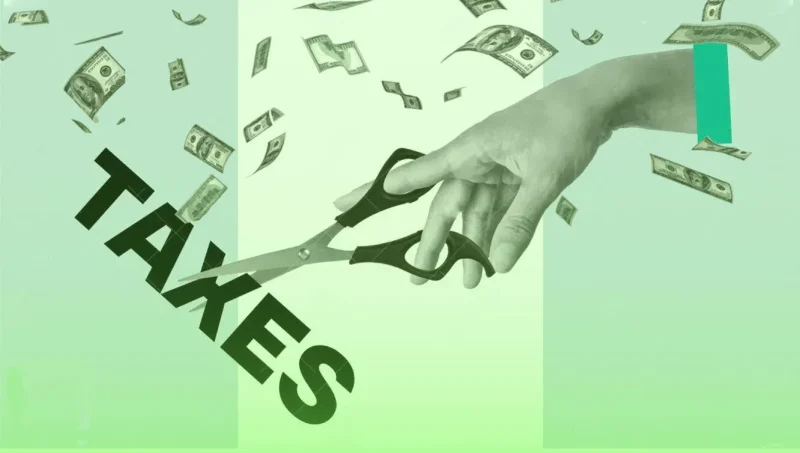One of the biggest mistakes you can make while investing is investing without taxes in mind, and so many beginners fail to consider the devastating impact of taxes on their investments, and get surprised when they see that a large chunk of their gains on their investments went to the IRS. When you accumulate money tax free, your money grows at a much faster rate, so here are the five best tax-free investments that you can invest in to grow your money and pay little to no taxes at the same time.
Real Estate
Real estate is a great investment if you want to grow your wealth, since the value of properties often appreciates over time. But not a lot of people know that real estate taxes can be reduced a lot, or even completely avoided. There are a couple of ways you can make real estate investing tax-free, and the first one is called the “live in flip” strategy. Basically, you buy a property and live in it for a minimum of two years and when you sell it, you may qualify for a capital gains exclusion, which can help you minimize, or completely avoid, paying taxes on the sale of your home.
This is because the profit you make when you sell your home will be taxed at a long-term capital gain rate, which can be from 0% to 20% depending on your filing status and income. In fact, even if you fall into the highest tax bracket, your long-term capital gains tax rate would be 20%, which is far less than the short-term rate at over 30%.
| Filing status | 0% | 15% | 20% |
| Single | $0 to $44,626. | $44,626 to $492,300. | $492,300 or more. |
| Married Filing Jointly | $0 to $89,250. | $89,251 to $553,850. | $553,850 or more. |
| Married Filing Separately | $0 to $44,625. | $44,625 to $276,900. | $276,900 or more. |
| Head of Household | $0 to $59,750. | $59,751 to $523,050. | $523,050 or more. |
Just keep in mind that you have to keep the home for more than one year to be taxed at a long-term capital gain rate, and you also have to live in it for two years, which don’t have to be consecutive. The exclusion is up to $250,000 in profit from the sale for an individual and up to $500,000 for a married couple filing for taxes jointly. Now, let’s say you bought a home a few years ago for $100,000, and sold it today for $500,000. This means that you made a profit of $400,000.
If you’re qualified for the capital gains excursion, then you won’t be taxed on $250,000 from that $400,000 if you’re single, meaning that you’ll only pay taxes on $150,000. And if you’re married and filing for taxes jointly with your spouse, you might pay $0 in taxes since the IRS allows married couples to deduct up to $500,000 in capital gain taxes.
Notably, you can also reduce capital gain taxes on your property by spending money on home improvements, because things like remodeling, expansions, and landscaping are tax-deductible, so make sure you hold onto the receipts for all major improvements you make. Another way you can avoid paying a high capital gain tax on the sale of your home is by selling it for unforeseeable events, like for work reasons or health reasons, and this might be able to remove some taxes from your final bill.
On the other hand, let’s say that you don’t live in the property and instead own rental properties, and you receive passive income from them in the form of rent, but a few years later, you decide to sell the properties. Naturally, since you didn’t live in these properties, you’d have to pay capital gains taxes, but there’s a way to defer these taxes by leveraging a 1031 Exchange. This is a real estate investing tool that allows you to defer your federal tax by taking the profit from the sale of one property and using it to buy another investment property, and this can be a great way for you to maximize your real estate investing profits, without having to pay a lot in taxes.
There’s another way to defer taxes on real estate properties, and it also can be an option to make real estate investing completely tax-free, and this is by investing in properties through a self-directed IRA, or make the route completely tax-free by utilizing a self-directed Roth IRA. This will defer the taxes until you withdraw the funds from your IRA account.
Municipal Bonds
Municipal bonds are tax free investments because they’re basically debt but you’re the lender and you give the local government money, so in return, the local government gives you a tax break. An ETF may just buy a whole bunch of those bonds, and if you buy that ETF, you invest in those tax-free bonds. These ETFs are offered by most brokerages, for instance, you have the iShares California Muni Bond ETF (NYSEARCA: CMF) and the Schwab Municipal Bond ETF (NYSEARCA: SCMB), but if you don’t want to buy a bond ETF, you can directly buy one municipal bond yourself through brokerage firms.
Their rates of return might not be very high, as the highest rate is around 2.39% now, but it’s still a tax free investment that’s also relatively very low risk, and you can use them to hedge against the risks of the overall stock market.
Treasury Securities
Treasury securities are also known as federal debt, and they’re tax free investments that work just like municipal bonds, but instead of lending money to the local government, you lend money to the federal government, which uses the money to fund things like infrastructure megaprojects, education, or the military. There are multiple types of treasury securities, and they include treasury bills, treasury notes, and treasury bonds. But, all of them are extremely similar and just have different terms and different tax treatments.
For example, treasury securities are normally exempt from state and local taxes, but are typically subject to federal taxes, so you need to be aware of the terms of your investment, and you can easily learn more about treasury securities, as well as buy them, on Treasurydirect.gov, which is a website managed by the government that you can use to invest in treasury securities.
Tax Free Life Insurance
Not a lot of people know that you can actually invest money through a life insurance policy, and what makes this so attractive to investors is that your earnings grow tax-free, similar to how a Roth IRA works. But, unlike with an IRA, you don’t have to wait to be a certain age to withdraw the money when you need it. If this sounds good for you, then you should look up an index universal life insurance plan.
This is basically life insurance that has a cash value, and this is important because the cash value is tax-free under Section 7702 of the internal revenue code. Here’s an example on how it works, let’s say you put $1,000 into your life insurance policy, and $100 of that is going to cover the cost of the actual insurance, and the remaining $900 will go into a tax-free account that you can use to invest in an index fund.
By now, you must be wondering about the catch, and of course there’s one, and it’s that the return on your investments in your life insurance plan will always be less than the performance of the actual index fund, because of the extra costs these accounts need because they buy options that hedge against the risk of the market losing value, so if the market loses 20%, you won’t lose anything.
Health Savings Accounts
Health saving accounts, or HSAs, are other accounts where you can invest tax-free, as long as you follow the account’s requirements, and these requirements include things like not being covered by any other medical plan, such as a spouse’s plan, so you need to check the requirements online to see if you qualify for an HSA or not. Basically, you can contribute up to $8,000 per year, depending on your filing status, and receive the following tax benefits: First of all, you’ll get a tax deduction based on the amount of money you contribute to the HSA, unlike normal life insurance and Roth accounts.
Secondly, your investment earnings will grow tax-free inside of your HSA. And number three, your withdrawals will be tax-free, if you qualify the money for qualified health expenses. A lot of people think that you can only use your HSA for doctor’s visits and medical procedures, but you can actually use it to pay for all sorts of health-related things, like gym memberships, massages, and chiropractic care, and it can allow you to write off any health-related expense.
The Bottom Line
It’s important to note that you should pay all what you legally owe in taxes to authorities, but you can reduce the amount of tax that you need to pay by investing in tax free investments. Still, you should keep in mind that these tax free investments have certain rules and regulations for you to be qualified for the tax write-offs, so make sure to do your own due diligence, and research your state’s tax regulations since they can differ from one state to the other.
You should know that spending a few hours on the IRS website before you file for taxes can save you a lot of money you could be paying in taxes, so try to learn as much as you can and even seek a tax professional’s advice if needed.
Disclaimer
Please visit and read our disclaimer here.









